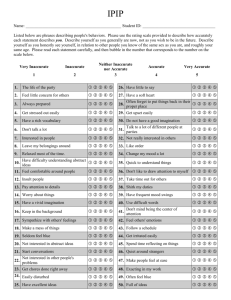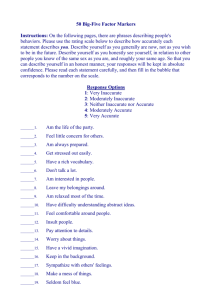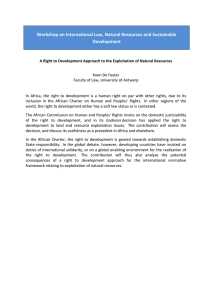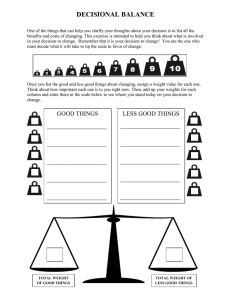A New Tool for Assessing Financial APS Training 2015
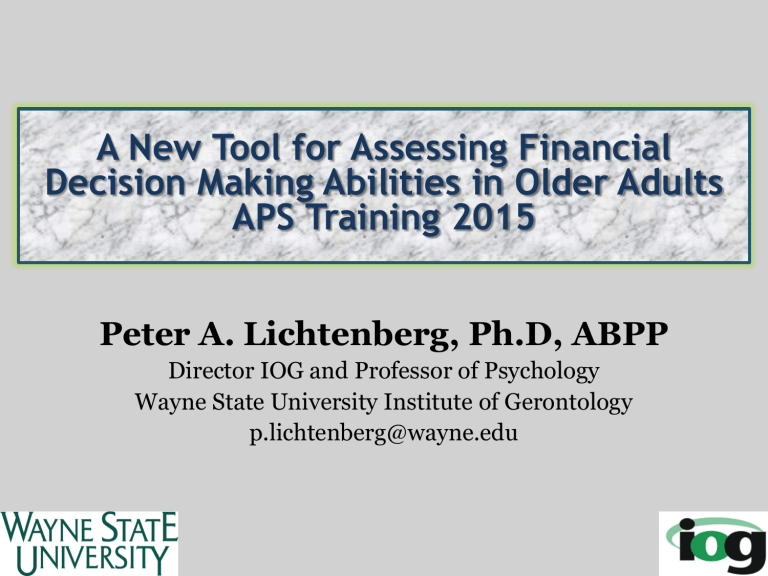
A New Tool for Assessing Financial
Decision Making Abilities in Older Adults
APS Training 2015
Peter A. Lichtenberg, Ph.D, ABPP
Director IOG and Professor of Psychology
Wayne State University Institute of Gerontology p.lichtenberg@wayne.edu
Acknowledgements
Research team at WSU
Lisa Ficker, Ph.D.
Annalise Rahman –Filipiak, MA
Evan Gross, MA
Michael Sugarman, MA
Daniel Paulson, Ph.D.
Elder Law of Michigan
Ron Tatro
Keith Morris
MiCPA
Judith Trepeck
APS
Cynthia Farrell
Rachel Richards
Legal Colleagues
Sandy Mall
Howard Collens
Pat Simasko
Oakland County SAVE task force
Expert Panelists
Funders:
National Institute of Justice
Retirement Research Foundation
~Bernard Baruch,
Age 84
United Nations
Diplomat
1.
Describe Capacity Assessment
2.
Examine different aspects of financial decision making
3.
Discuss the research on how cognitive decline impacts decision making
4.
Review Types of Financial Exploitation
5.
Examine new methods of Assessment for decision making capacity
“Doctor, I need to know if..”
Client can…
• Make own medical decisions
• Manage own finances
(conservatorship)
• Manage living independently
(guardianship)
• Create or change will/trust
(testamentary)
• Make his or her own medical decision
Capacity versus Competency
• Capacity denotes a clinical status determined by a health care professional
• Competency denotes a legal status determined by a judge
• Burden of proof lies with alleging party
Clinician role in Competency
•
Judges look to Experts to apply clinical data to the legal standards
•
Capacity assessments often form the basis of competency decisions
5 Aspects of clinical capacity assessment
1. Clinical Diagnoses: dementia, depression, substance abuse?
Critical to review records of others thoroughly and incorporate those records into one’s own evaluation
Clinical Diagnosis Cont.
Diagnostic procedures should meet highest standards of profession: Practice Guidelines a.
Commonly used assessment procedures/laboratory tests b.
Staging (in cases of dementia)- Clinical Dementia
Rating (CDR)
Global Deterioration Scale GDS c. FDA-approved or other treatments—well documented
2. Specific Capacity Assessment
• Financial management
• Medical consent
• Self-care
3. Awareness of Deficit and
Ability to Compensate
• Ethical Directive: Clinicians aim to enhance client autonomy to the best of their abilities
• Are there compensatory strategies available: recognition v recall, memory notebooks, etc.
• Very hard to determine how to use this—clinical judgment
4. Evidence of Any Undue
Influence
• Not typically formal part of legal statute
• Ex: Blum’s IDEAL model
– I solation
– D ependency
– E motional Manipulation and/or E xploitation of Vulnerability
– A cquiescence and
– L oss
4. Evidence of Any Undue
Influence
• Susan Bernatz SCAM model
• Susceptibility
• Confidential Relationship
• Active Procurement
• Monetary Loss
5. Apply clinical data to legal standards
•
Calls for specific application of clinical data to specific legal standards
•
Can include both statutes and case law issues—attorney should be able to assist you on this
Financial Competency
• Cornerstone assessment in most FE cases
• Competency=Autonomy
• Incapacity= Need for Protection
• BALANCING ACT: OVER-PROTECTION
AS HARMFUL AS UNDER-PROTECTION
1.
Basic Monetary Skills
2.
Financial Conceptual Knowledge
3.
Cash Transactions
4.
Checkbook Management
5.
Bank Statement Management
6.
Financial Judgment
7.
Bill Payment
8.
Knowledge of Assets/Estate Arrangements
1.
Executional
2.
Decision-Making
Random samples help us understand the range of individual differences
Hsu and Willis : 10 year study of couples where one person had cognitive decline:
• Money management problems preceded giving up control of finances
• 33% of persons with dementia remained the primary financial decision maker
• 25% of sample where one partner was cognitively in the range of dementia retained decision making capacity despite loss of executional skills
Early
Cognitive
Decline
Impaired
Financial
Decisional Skills
Vulnerability to Financial
Exploitation
(1) the potential loss of financial skills and financial judgment; and (2) the inability to detect and therefore prevent financial exploitation.
Stiegal 2012
• Viewed in similar fashion to domestic violence
• Physical abuse cases can be extreme and upsetting
• Until recently financial exploitation seen as lower priority as the harm was not perceived to be as great.
• Alzheimer’s Disease research pays little attention to elder abuse
• MetLife Study – impact estimated at 2.9
Billion dollars per year, and 10% increase between 2008-2010.
• Study measured media coverage not incidence
Conrad et al. (2010)
•
• Hybrid FE
: More likely to co-habitate and suffer from dementia; Lost an average of $185,574; also suffered physical abuse and/or neglect
• Pure FE
: Lost an average of $79,422; theft most common form (47%); fraud
(32%)
Jackson and Hafemeister (2012)
• Formed 2 New Scales:
Lichtenberg Financial Decision
Making Rating Scale ( LFDRS )
Lichtenberg Financial Decision
Screening Scale ( LFDSS )
Overall Goal :
Assessment at Point of
Decision
• People are more than the sum of their cognitive abilities
• Traditional approaches overemphasize deficits and under-emphasize strengths
• Subjective experience of PWD remains important
• Originally for capacity for psychiatric treatment and guardianship, then health decisions
• ID 4 aspects of decision making:
Communicating
1.
Choice
2.
Understanding
3.
Appreciation
4.
Reasoning
• Capacity to enter into a contract (e.g. real estate)-- Estate of Erickson
202 Mich APP 329, 331, 508 NW2d 181 (1993) indicates that person executing a real estate contract such as a home equity loan must possess sufficient mind to understand, in a reasonable manner the nature and
effect of the act in which he is engaged.
• Testamentary capacity in Michigan requires (per MCLA 700.2501,
700.7601) that the person making a will
1.
Understand the purpose of the document;
2.
Has the ability to know the nature and extent of his or her property;
3.
Knows the natural objects of his of her bounty; and
4.
Has the ability to understand in a reasonable manner the general nature and effect of his or her in signing the will (or trust per
700.7601).
• Rationale/Reasoning—implicit to these, but so important to consider
• Using the Concept Mapping Model (Conrad et al., 2010) we then assembled two groups of experts:
– 6 were engaged in financial-capacity work across the nation and
– 14 were local and worked directly, on a daily basis, with older adults making sentinel financial decisions and transactions
• 4 phone conferences held total (2 per group)
Financial
Situational
Awareness
Psychological
Vulnerability
Undue Influence
Past Financial
Exploitation
Express:
-
Choice
-
Rationale
-
Understanding
-
Appreciation
Peter A. Lichtenberg PhD, ABPP, Lisa J. Ficker PhD & Annalise
Rahman-Filipiak MA (2015):
Financial Decision-Making Abilities and Exploitation in Older African
Americans:
Preliminary Validity Evidence for the Lichtenberg Financial Decision
Rating Scale (LFDRS),
Journal of Elder Abuse & Neglect,
DOI: 10.1080/08946566.2015.1078760
Peter A. Lichtenberg, Ph.D.,
ABPP*
Wayne State University
Institute of Gerontology
87 E Ferry Street
Detroit, MI 48202
313-664-2633 (phone)
313-663-2667 (fax) p.lichtenberg@wayne.edu
Lisa J. Ficker, Ph.D.
Wayne State University
Institute of Gerontology
87 E Ferry Street
Detroit, MI 48202
Annalise Rahman-
Filipiak, M.A.
Wayne State University
Institute of Gerontology
87 E Ferry Street
Detroit, MI 48202
Table 1: Descriptive Statistics for Sample Characteristics (n =
69)
Age
Gender
Female
Male
Education
WRAT-R Reading
Grade Level
% (n) M (SD)
69.59 (5.99)
89.9 (62)
10.1 (7)
14.75 (2.48)
10.40 (3.00)
Current Financial
Decision or Transaction
Investment/Estate Planning 18%
Major Purchase 64%
Financial difficulty (e.g. bankruptcy) 18%
Peter A. Lichtenberg, Ph.D., ABPP, Wayne State University
Table 2: Financial Exploitation and Decisional Ability Concern Frequencies (n = 69)
Financial Exploitation
Yes
No
Decisional Ability
Concerns
Major Concerns
Some Concerns
No Concerns
% (n)
18.81 (13)
81. 2 (56)
4.3 (3)
7.2 (5)
88.4 (61)
Table 3: Correlations between LFDRS Decisional Ability and Subscale Scores,
Demographic, Cognitive, and Functional Variables (n = 69)
Decisional Ability r
Financial
Situational
Awareness
Psychological r
Vulnerability
Current Decision
Total r r
Past Decision
Total r
Undue Influence r
Age
Education r r
Age
.126
-.053
-.024
.163
-.019
.040
Educatio n
.235*
-.124
-.098
-.011
-.062
-.028
MMSE
.327**
-.084
.004
-.226*
-.061
.026
-.101
.254*
Note. ** = Significant at α =.005 level * = significant at α =.05 level
ILS Money
Mgmt.
.254*
.043
-.001
-.204*
-.037
-.054
-.080
240**
Table 4: Correlations between LFDRS Subscales (n=69)
1 2 3 4 5 6
1. Decisional
Ability
2. Financial
Situational
Awareness
3. Psychological
Vulnerability r r
4. Current
Decision Total r
5. Past Decision
Total
6. Undue
Influence r r r
-.304** -.210* -.364** .095
-.221*
.388** .171
.085
.284**
-.047
.167
.266**
-.070
.066
Note. ** = Significant at α =.005 level * = significant at α =.05 level
.158
---
χ 2 = 12.2, p = .002
Overall, how satisfied are you with your finances?**
Satisfied
Neither satisfied nor dissatisfied
Financial
Exploitation
23.1 (3)
15.4 (2)
No Financial
Exploitation
41.1 (23)
46.4 (26)
Dissatisfied 61.5 (8) 12.5 (7)
χ 2 = 13.5, p = .001
How confident are you in making big financial decisions?**
Financial
Exploitation
No Financial
Exploitation
Confident 23.1 (3) 76.8 (43)
Unsure 69.2 (9) 19.6 (11)
χ 2 = 14.1, p = .001
How worried are you about having enough money to pay for things?**
Not at all worried
Somewhat worried
Financial
Exploitation
7.7 (1)
46.2 (6)
No Financial
Exploitation
41.1 (23)
50.0 (28)
Very worried 46.2 (6) 8.9 (5)
χ 2 = 5.7, p = .017
Do you regret or worry about financial decisions you've recently made?**
No
Financial
Exploitation
30.8 (4)
No Financial
Exploitation
71.4 (40)
Yes 69.2 (9) 28.6 (16)
• 10 items: To be administered in an interview format
• Multiple choice
• Focuses on the 4 intellectual factors and potential for undue influence
• Professional does the rating on each item and does not just record older adult’s responses.
• Overall judgment score based in part on don’t know or inaccurate responses.
It Is:
• A way to understand the older adult’s perspective on the situation
• Part of an assessment, just as observation, record reviews and other interviews are
• A novel way to assess informed decision making
It Is Not:
• A check the box and look at the score test
• A complete interview: it often raises more questions
• Something that takes the place of the interviewer’s skills
APS
• 28 cases 64% cases substantiated
• 18 substantiated; 11 women, 7 men
• No differences between groups in age, education
Other Front Line
Professionals
• 78 cases attorneys, FP,
Health Care
• 12% base rate of concerns (13 of 78)
• No differences between groups in age, education
Independent Samples t -Tests for the LFDSS Total Risk Score for Current Financial Decision
LFDSS Total for Current
Decision
Some or Major
Concerns
Decisional Ability
No Concerns
LFDSS Total for Current
Decision
LFDSS Total for Current
Decision
APS Case
Substantiated
APS Case Not
Substantiated
Professional Case:
Do not move forward
Professional Case:
Move forward w/ decision
M (SD)
15.00
(6.6)
8.56
(2.1)
14.50
(6.3)
8.20
(2.0)
17.42
(6.8)
8.63
(2.1) t
5.47
3.06
-4.41
df
106 .0001
26 .005
77 p
.001
LFDSS Item comparisons:
FE v non FE
• Impact on Finances: 33% negative; 23% inaccurate vs. 1% negative and 3% inaccurate
• Risk Level: 24% high risk; 33% inaccurate about risk level vs. 4% high risk and 1% inaccurate
• Decision itself: 42% inaccurate about decision in question vs 2%
• The LFDSS is a structured, multiple choice interview that should be administered in a standardized fashion. In introducing the LFDSS to the older adult, read out loud the following one-sentence explanation:
“ I am going to ask you a set of questions to better understand the financial transaction/decision you are making or have already made. Please answer these as best you can and feel free to elaborate on any of your answers.
”
Decisional Ability
Questions 1-2
1.
What is the financial decision you are making?
a) Investment planning (retirement, insurance, portfolio balancing) b) c)
Estate planning (will, beneficiary, gifts)
Major purchase (home, car, renovations) d) Don’t know/inaccurate
2.
Was this your idea or did someone suggest it or accompany you?
a) My idea b) c)
Someone else suggested/drove me here
Don’t know/inaccurate
Scale cannot be used without permission of Dr. Lichtenberg
Questions 3-5
3. What is the purpose of you decision?
a) Benefit self, plan, peace of mind b) c) d) e)
Benefit family (whom?)
Benefit charity (which?)
Benefit someone else (whom?)
Don’t know/inaccurate
4. What is the primary financial goal?
a) Earn money through investment b) c)
Share wealth
Give someone access to my money d) e)
Gift someone or a charity
(Which?)
Don’t know/inaccurate
5. How will this decision impact you now and over time?
a) b)
Improve financial position
No impact c) d)
Negative impact/debt
Don’t know/inaccurate
Questions 6-7
6. How much risk is involved?
a) Low risk or none b) Moderate risk c) High risk d) Don’t know/inaccurate
7. How may someone else be negatively affected?
a) No one will be negatively affected b) Family members (who and why?) c) Someone else (who and why?) d) Charity (which and why?) e) Don’t know/inaccurate
Scale cannot be used without permission of Dr. Lichtenberg
Questions 8-10
8. Who benefits most from this financial decision?
a) I do b) Family c) Friend d) Caregiver e) Charity/organization f) Don’t know/inaccurate
9. Does this decision change previous planned gifts or bequests to family, friends, or organizations?
a) No b) Yes (who and why?) c) Don’t know/inaccurate
10. To what extent did you talk with anyone regarding this decision?
a) Not at all b) Mentioned it (to whom?) c) Discussed in depth (with whom?) d) Don’t know/inaccurate
Case #1: A 68-year-old high school graduate is considering buying a new home for her grandson.
• She has relatively few resources herself and this purchase would put her at risk for financial hardship
• She will lack access to the cash she will spend and that she will be responsible for the mortgage payments
• She would be financially responsible should her grandson decide to no longer pay the monthly bills.
• Grandson is marginally employed and has no financial resources; making an investment in him a significant risk.
LFDSS Questions and Answers:
• #2 Your idea or did someone else suggest this? “My grandson’s idea but I like it.”
• #4 Primary financial goal? She is unsure.
• #5 How will decision impact you now and over time? She says it will improve her position but Rater said that is inaccurate.
• #6 How much risk to your financial well-being? She says none;
Rater says that there is moderate to high risk and therefore response is inaccurate.
• #8 Who benefits most from this decision? She reports “I do” but clearly grandson would be major beneficiary.
The Rater marks this a 0 for Decisional Abilities, “Major
Concerns,” and Substantiates case
Let’s Review :
• The woman in question communicates:
– Choice (buy a home for her grandson)
– Rationale (he will have a nice place to live)
• But the woman lacks:
– Understanding (goal, who benefits)
– Appreciation (financial impact, risk to financial well-being)
Case #2 : 77 year old high school educated woman.
• #1 Decision: To name daughter POA and add daughter to her bank account
• #2 Daughter suggested it
• #5 Daughter is going to use money but promises to pay back
• #6 No risk
• #8 States she benefits most
• Woman has clear dementia
• Outcome: Restitution in process, no criminal charges
Case #3: 86 year old man; master’s degree
• #1 Financially support his daughter
• #2 His idea
• #3 Purpose: Benefit family — love her
• #4 Impact on finances: None/slight
• #6 Risk to financial well being: Small
• #8 Who benefits most: Family
• #10 Discuss with? No one
• No Decisional Ability Concerns
• Case not substantiated for FE
• When you want to better understand an older adult’s financial decision(s) or transaction(s)
• Build Rapport first— then ask some of the easy questions about finances—
1.
How confident with financial decisions,?
2.
How anxious about money decisions?
3.
Any financial decisions you regret or worry about?
• When administering the scale: Make it conversational and not robotic/don’t rapid fire questions
• Ask for clarification and elaboration on items after scale has been administered
• Use a counseling/education approach with your clients
• Find ways to bring a third party in to discuss matter also
• Slow process down—do not execute documents that day and make older person return
• Call Adult Protective Services if Financial
Exploitation is discovered and cannot be resolved.
Lichtenberg
Scales : The last collaboration with my late wife and colleague
Peter Lichtenberg, Ph.D.
Email: p.lichtenberg@wayne.edu
Phone: Office 313-664-2633
Cell 248-497-3088
Fax: 313-664-2667

